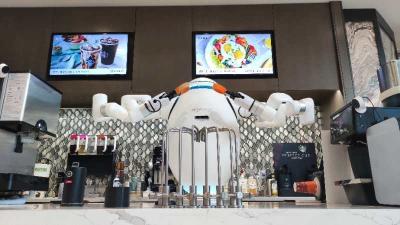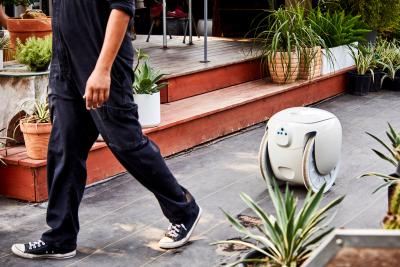Although robots are in their infancy within the hotel space, operations and guest experience teams can benefit from adding machines to address tasks from cleaning to security, especially as labor shortages affect hotels’ ability to stay ahead of the workload.
Robots generally don’t need breaks and can work around the clock as long as they are appropriately charged. They can do the grunt work and free up hotel staff to attend to guests or other tasks on property. But the hotel robots are also helping guests as well: It can be much quicker and more convenient to have a robot deliver the extra pillow or the room service directly to the guestroom. Hospitality robots also can provide some concierge services and can work at the in-house coffee shop.

The global market for hotel robots is expected to grow from $79 million in 2020 to $338 million by 2025, at a compound annual growth rate of 32.8 percent, according to a report by MarketsandMarkets. This growth is being driven by the need for efficient and cost-effective solutions.
“Robots in the hospitality industry are not replacing humans,” said Michael Blake, chief technology officer at the American Hotel & Lodging Association. “Robotics are allowing hotel employees to do their work better, more efficiently and more quickly. That’s why—and where—robotics are coming into play in hospitality.”
“Unlike having a staff shortage in a department, the robot is always here in a position where we would not have had a staff member in the first place,” said Tom Beedon, GM of the Residence Inn by Marriott Beverly Hills (Calif.). “Especially in a limited-service hotel environment, which has been my primary experience with the robot, it has been a reliable and sustainable addition to the operation that provides a service and delights the guests.”
But that assistance can come with its challenges as well.
“In the hotel industry today, robotics-related offerings tend to be focused on a specific function, such as vacuuming or delivering certain items to guests, rather than multidimensional performance of tasks,” said Chris O’Donnell, chief operating officer of Atrium Hospitality. “The cost-effectiveness and efficiency associated with a hotel task performed by a robot are limited. A trained hotel team member is necessary for cleaning the overall space where a robot has vacuumed or to provide the correct guest-requested item from human-managed inventory for delivery via robot.

“In addition, using a robot in public areas is still a novelty, and the technology may not always respond correctly in unanticipated situations,” O’Donnell continued. “We’ve found that the uniqueness of a working robot at a hotel can sometimes lead to guests’ inappropriate interference with a robot’s task.”
Where Are the Robots?
Automation alleviates staff shortages while simultaneously improving efficiencies. “While it is still the early adoption stage of this emerging technology, there are a lot of practical applications of robots that we are seeing in hotels,” said Dominic Locascio, senior director of hospitality sales for Piaggio Fast Forward. “The more common ones are those that delight the guests and add to the experience—things like food or towel delivery, assistance with carrying guest or hotel staff items or help for guests who have limited mobility. But we are also seeing more applications that help with staffing challenges such as cleaning, automation for handling cleaning materials or amenities, and some hotels are using robots as check-in agents.”
In many industries, finding labor for cleaning can be a major pain point. Hotels have miles of carpet to vacuum, but it’s increasingly difficult to find employees to vacuum carpets for eight hours a day, said Elad Inbar, founder and CEO of RobotLAB. “Cleaning robots have emerged as a solution to this issue by autonomously cleaning floors and navigating varied obstacles,” he said. “With one-time mapping taking only a couple hours to prepare, robots can quickly step in and provide the services needed. Some robots even have the capability to refill and empty their clean and dirty tanks, requiring minimal human intervention. With the ability to clean more than 10,000 square feet on a single charge, cleaning robots offer an immediate solution and a cost-saving advantage.”
More intuitively, robots can also help create sustainable teams for hoteliers, said Gavin Donley, senior product marketing manager at Brain Corp. “This is particularly important during staff shortages when hotels may struggle to find enough staff to meet guest needs,” he continued. “By automating certain tasks, hotels can make up for any lack of availability when it comes to human workers. Robots can also perform tasks with a high level of consistency, reducing the risk of human error. This can be especially important in areas such as cleaning and maintenance, where consistency is crucial to maintaining a high standard of hygiene and safety for guests.”
Further, machines can help personalize and enhance the guest experience by providing services such as in-room voice assistants, robotic concierge services and robotic butlers.
Delivery robots are also becoming increasingly popular in the hospitality industry. They help ease the burden of short staffing for roomservice and restaurants. Several robot manufacturers offer models that can call elevators and doors, with fleet integration to synchronize robot’s paths and optimize travel time and routes. These robots are self-charging and typically require minimal intervention and maintenance.
Dining service robots can bring dishes back and forth to the kitchen, freeing up servers to focus on guests and can work a 15-hour shift on a single charge, said Jane Li, director of partnership at Richtech Robotics. In addition to delivering meals and clearing dishes, there are some robots that can actually prepare the beverages and even the food. There is a barista robot that is currently operating in a hotel that can take orders directly from guests due to having natural language processing skills. ADAM can be an interactive barista, bartender and a sous chef.
“Guests love the robots, especially in restaurants—they actually want the robot to deliver the food,” said Richtech Robotics COO Phil Zheng. “It’s unique and novel to the guests.”
But it’s also a triple win: In addition to capturing guests’ attention, it saves the property with labor and cost savings, and it also helps the current property staff by saving them time and they often receive many tips because they are offering better, quicker service of more tables and more guests, Zheng continued.
Robots are increasingly being used as assistants to the lobby attendants delivering packages, such as DoorDash deliveries, to guestrooms. Newer versions of robots can carry up to 80 pounds so hotels are using them to deliver items to staff members, such as housekeeping, throughout a property, said Juan Higueros, co-founder and COO of Bear Robotics. “Imagine a large hotel or even casino—trip time to deliver a package can take 20 to 30 minutes round-trip,” he said. A robot can free an employee up from a mundane task, Higueros continued, and can let the employee be more efficient.
Concierge robots are gaining popularity as they can converse with guests, answer frequently asked questions, check guests into rooms, provide local information and even guide guests to specific facility spaces. These robots also can provide extra security as a patrol officer, and with their large displays, they can even be used for digital advertising space.
The Challenges with Hotel Robots
For the hotel industry to overcome obstacles and improve, innovation is essential, including testing new technologies. “Hoteliers can continue to collaborate with technology providers in fine-tuning robotics for the customer-centric hotel industry,” O’Donnell said. “Communication is key to the success of the use of robots in hotels. Monitoring feedback from guests and team members and evaluating their interactions with robotics technology on property can assist with assessing the potential for mainstream adoption of robots in the hotel industry.”
One major challenge with robotics is the cost of implementing and maintaining a robotic infrastructure. Another challenge is the lack of standardization—there is no industry-wide standards for hotel robots, which makes it difficult for hoteliers to compare and select the right robot for their needs.
Existing hotels weren’t commonly built with robots in mind so installing robotic devices in hotels can come with initial challenges—some more obvious than others. For starters, integrating robots with the existing hotel infrastructure, including the property-management system, the Wi-Fi network, point-of-sale systems, elevators and other technologies can be complex in the initial stages, Donley said. “Safety is another priority: It’s important to ensure that any robots deployed are able to operate safely around humans, avoiding collisions and other hazards.”
Other practical physical challenges include swinging doors, multilevel or uneven flooring and ADA ramps, Higueros said. Hotel staff may require training on how to program robots, as well as how to troubleshoot and perform basic maintenance tasks. Managers need to ensure that this is all part of the deployment package. With deployments still growing in most hospitality sectors, robots can be a novel surprise to guests.
Something Stephen Hatley, director of strategic accounts for ICE Cobotics NA, stresses with potential clients is the importance of “change management.”
“Everyone in the company must be on board with implementing automation. From the expectations around day-to-day use, to daily maintenance requirements, all the way to reviewing metrics and data, why it is important and how it can contribute to the success of the company must be woven throughout the organization,” he said.
